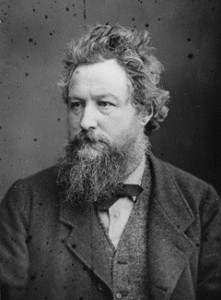 William Morris was a poet and writer who was also at the forefront of textile arts in the latter half of the nineteenth century in England. He was born in 1834 in Essex and was from a relatively well-off middle class family. His father was in finance and his mother was descended from a wealthy middle England family. Confined to the house in early childhood, he loved reading and enjoyed the novels of Walter Scott such as Ivanhoe and Rob Roy.
William Morris was a poet and writer who was also at the forefront of textile arts in the latter half of the nineteenth century in England. He was born in 1834 in Essex and was from a relatively well-off middle class family. His father was in finance and his mother was descended from a wealthy middle England family. Confined to the house in early childhood, he loved reading and enjoyed the novels of Walter Scott such as Ivanhoe and Rob Roy.
When the family moved to Woodford in Essex he started to explore the countryside and took up riding. His interest in the country and ancient historical sites such as Avebury continued when he went to Marlborough College in Wiltshire. A few years later he went to Oxford to study the Classics and Medieval history, embracing its strong sense of chivalry that he preferred to the rapid industrialization of the modern world.
At university he met Edward Burne-Jones whom he would form a long friendship that would see many periods of collaboration and a commitment to a life founded in art. After graduating, William Morris set out to be an apprentice in London but soon gave that up, and was convinced by Dante Rossetti to take up painting instead.
He was writing at the same time and in 1857 published a book of poetry called The Defence of Guenevere which was largely unsuccessful. He met Jane Burden at a theatrical performance and quickly became infatuated with her. They married shortly after in 1859 but Burden later admitted that she had never felt any love for Morris and there is evidence that she carried on an affair with Rossetti. Morris built the Red House in Bexleyheath and there settled down with his new wife. He moved away from artistic painting towards interior design, creating wallpapers and forming his own decorative arts company that would become world famous.

Although his main work was in design, Morris continued to write poetry and in 1867 published the epic The Life and Death of Jason, a retelling of the Golden Fleece legend, which was received quite well. This was followed by The Earthly Paradise which became something of a cult success.
Around this time William Morris became interested in Icelandic tales and worked on many translations of the old legends but also started to become more active in politics, particularly from 1880 onwards, joining organizations such as the National Liberal League. He was critical of Gladstone’s government of the time and was a social activist throughout most of his later life.
His poetic works were greatly influenced by Romanticism and he is often credited with being the father of fantasy fiction. He despised the rampant capitalism and industrialization of the age that he lived in and was often noted for his wild temper. In 1888 he published The House of the Wolfings, a story based in the Iron Age and was a mix of straight prose and poetry. A sequel quickly followed as did other works of poetry such as The Wood Beyond the World and The Sundering Flood.

With growing signs of epilepsy and bouts of painful gout, by the 1890s William Morris was becoming ill and soon was housebound as an invalid. He passed away in 1896 and was buried at St George’s Church in Kelmscott.

